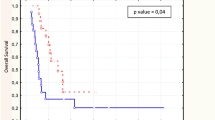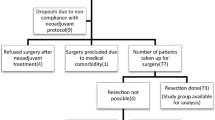Abstract
Objectives
The objectives of this study were to reveal the utility of 18F-fluorodeoxyglucose positron emission tomography (FDG-PET) within 7 days after chemoradiotherapy to predict prognosis in patients with postoperative recurrent esophageal cancer.
Materials and methods
Patients scheduled to undergo concurrent chemoradiotherapy for postoperative locoregional recurrence of esophageal cancer were recruited. Selection criteria were: (1) locoregional recurrence, (2) no previous radiation therapy, (3) planning treatment with concurrent chemoradiotherapy, (4) FDG-PET performed <2 weeks before chemoradiotherapy, and (5) no serious diabetes. FDG-PET was performed <7 days after chemoradiotherapy. No more treatment after chemoradiotherapy was given until disease progression was diagnosed according to the Response Evaluation Criteria in Solid Tumors (RECIST). Correlations of FDG-PET findings with cause-specific survival and local control rates were investigated prospectively.
Results
Twenty patients were enrolled. Median observation period of patients who survived was 45.0 months. Median maximum standardized uptake value (SUVmax) after chemoradiotherapy was 2.4, and median SUVmax before chemoradiotherapy was 8.4. Cause-specific survival and local control rates were significantly better for patients with SUVmax ≤ 2.4 after chemoradiotherapy (log-rank test, P = 0.033 and 0.010, respectively). SUVmax before chemoradiotherapy tended to be correlated only with cause-specific survival rate (log-rank test, P = 0.076). Change in metabolic activity of FDG was significantly correlated with local control rate (log-rank test, P = 0.042).
Conclusions
FDG-PET performed even <7 days after chemoradiotherapy predicts prognosis in patients with postoperative recurrent esophageal cancer.




Similar content being viewed by others
References
Flamen P, Lerut A, Van Cutsem E et al (2000) The utility of positron emission tomography for the diagnosis and staging of recurrent esophageal cancer. J Thorac Cardiovasc Surg 120:1085–1092
Kato H, Miyazaki T, Nakajima M et al (2004) Value of positron emission tomography in the diagnosis of recurrent oesohageal carcinoma. Br J Surg 91:1004–1009
Duong CP, Demitriou H, Weih L et al (2006) Significant clinical impact and prognostic stratification provided by FDG-PET in the staging of oesophageal cancer. Eur J Nucl Med Mol Imaging 33:759–769
Kato H, Kuwano H, Nakajima M et al (2002) Comparison between positron emission tomography and computed tomography in the use of assessment of esophageal carcinoma. Cancer 94:921–928
Fukunaga T, Okazumi S, Koide Y et al (1998) Evaluation of esophageal cancers using fluorine-18-fluorodeoxyglucose PET. J Nucl Med 39:1002–1007
Blackstock AW, Farmer MR, Lovato J et al (2006) A prospective evaluation of the impact of 18-F-fluoro-deoxy-D-glucose positron emission tomography staging on survival for patients with locally advanced esophageal cancer. Int J Radiat Oncol Biol Phys 64:455–460
Swisher SG, Erasmus J, Maish M et al (2004) 2-Fluoro-2-deoxy-d-glucose positron emission tomography imaging is predictive of pathologic response and survival after preoperative chemoradiation in patients with esophageal carcinoma. Cancer. 15:1776–1785
Downey RJ, Akhurst T, Ilson D et al (2003) Whole body 18FDG-PET and the response of esophageal cancer to induction therapy: results of a prospective trial. J Clin Oncol 21:428–432
Brucher BL, Weber W, Bauer M et al (2001) Neoadjuvant therapy of esophageal squamous cell carcinoma: response evaluation by positron emission tomography. Ann Surg 233:300–309
Nishimura Y, Koike R, Nakamatsu K et al (2003) Concurrent chemoradiotherapy with protracted infusion of 5-FU and Cisplatin for postoperative recurrent or residual esophageal cancer. Jpn J Clin Oncol 33:341–345
Raoul JL, Le Prise E, Meunier B et al (1995) Combined radiochemotherapy for postoperative recurrence of oesophageal cancer. Gut 37:174–176
Shimada H, Kitabayashi H, Nabeya Y et al (2003) Treatment response and prognosis of patients after recurrence of esophageal cancer. Surgery 133:24–31
Nemoto K, Ariga H, Kakuto Y et al (2001) Radiation therapy for loco-regionally recurrent esophageal cancer after surgery. Radiother Oncol 61:165–168
Nemoto K, Matsushita H, Ogawa Y et al (2003) Radiation therapy combined with cis-diammine-glycolatoplatinum (Nedaplatin) and 5-fluorouracil for untreated and recurrent esophageal cancer. Am J Clin Oncol 26:46–49
Yamanaka H, Motohiro T, Michiura T et al (1998) Nedaplatin and 5-FU combined with radiation in treatment for esophageal cancer. Jpn J Thorac Cardiovasc Surg 10:943–948
Jingu K, Nemoto K, Matsushita H et al (2006) Results of radiation therapy combined with nedaplatin (cis-diammine-glycoplatinum) and 5-Fluorouracil for postoperative locoregional recurrent esophageal cancer. BMC Cancer 6:50
Kubota R, Yamada S, Kubota K et al (1992) Intratumoral distribution of fluorine-18-fluorodeoxyglucose in vivo: high accumulation in macrophages and granulation tissues studied by microautoradiography. J Nucl Med 33:1972–1980
Kubota K, Yokoyama J, Yamaguchi K et al (2004) FDG-PET delayed imaging for the detection of head and neck cancer recurrence after radio-chemotherapy: comparison with MRI/CT. Eur J Nucl Med Mol Imaging 31:590–595
Kato H, Kuwano H, Nakajima M et al (2002) Usefulness of positron emission tomography for assessing the response of neoadjuvant chemoradiotherapy in patients with esophageal cancer. Am J Surg 184:279–283
Schmidt M, Bollschweiler E, Dietlein M et al (2009) Mean and maximum standardized uptake values in [18F]FDG-PET for assessment of histopathological response in oesophageal squamous cell carcinoma or adenocarcinoma after radiochemotherapy. Eur J Nucl Med Mol Imaging 36:735–744
Lodge MA, Lucas JD, Marsden PK et al (1999) A PET study of 18FDG uptake in soft tissue masses. Eur J Nucl Med 26:22–30
Nakamoto Y, Higashi T, Sakahara H et al (2000) Delayed (18)F-fluoro-2-deoxy-d-glucose positron emission tomography scan for differentiation between malignant and benign lesions in the pancreas. Cancer 89:2547–2554
Zhuang H, Pourdehnad M, Lambright ES et al (2001) Dual time point 18F-FDG PET imaging for differentiating malignant from inflammatory processes. J Nucl Med 42:1412–1417
Matthies A, Hickeson M, Cuchiara A et al (2002) Dual time point 18F-FDG PET for the evaluation of pulmonary nodules. J Nucl Med 43:871–875
Ma SY, See LC, Lai CH C et al (2003) Delayed (18)F-FDG PET for detection of paraaortic lymph node metastases in cervical cancer patients. J Nucl Med 44:1775–1783
Yen TC, Chang YC, Chan SC et al (2005) Are dual-phase 18F-FDG PET scans necessary in nasopharyngeal carcinoma to assess the primary tumour and loco-regional nodes? Eur J Nucl Med Mol Imaging 32:541–548
Flamen P, Van Cutsem E, Lerut A et al (2002) Positron emission tomography for assessment of the response to induction radiochemotherapy in locally advanced oesophageal cancer. Ann Oncol 13:361–368
Kostakoglu L, Goldsmith SJ (2004) PET in the assessment of therapy response in patients with carcinoma of the head and neck and of the esophagus. J Nucl Med 45:56–68
Weber WA, Ott K, Becker K et al (2001) Prediction of response to preoperative chemotherapy in adenocarcinomas of the esophagogastric junction by metabolic imaging. J Clin Oncol 19:3058–3065
Wieder HA, Brucher BL, Zimmermann F et al (2004) Time course of tumor metabolic activity during chemoradiotherapy of esophageal squamous cell carcinoma and response to treatment. J Clin Oncol 22:900–908
Conflicts of interest statement
There is no conflict of interest in relation to this study.
Author information
Authors and Affiliations
Corresponding author
About this article
Cite this article
Jingu, K., Kaneta, T., Nemoto, K. et al. 18F-fluorodeoxyglucose positron emission tomography immediately after chemoradiotherapy predicts prognosis in patients with locoregional postoperative recurrent esophageal cancer. Int J Clin Oncol 15, 184–190 (2010). https://doi.org/10.1007/s10147-010-0044-y
Received:
Accepted:
Published:
Issue Date:
DOI: https://doi.org/10.1007/s10147-010-0044-y




